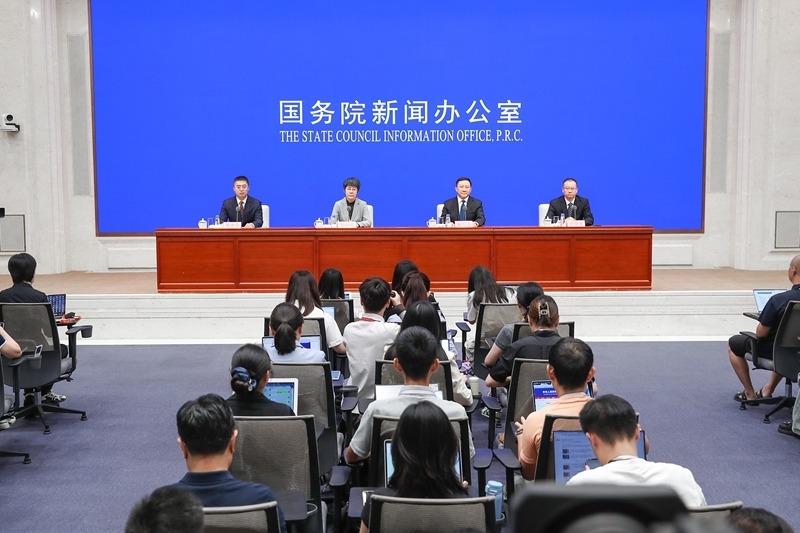Fundamentals back economic growth
Macroeconomic policies steer recovery through deep challenges


Despite the complex and volatile external environment, the fundamentals underpinning China's economic growth remain strong, and the policy toolkit at the government's disposal is well-equipped to foster sustained economic growth, analysts said.
Their comments came after a State Council executive meeting in late July called for efforts to bolster the effectiveness of its macroeconomic policies and make concerted efforts to tackle deep-seated challenges, in order to stay on track with its annual goals.
China is targeting an economic growth rate of around 5 percent for this year, according to the country's government work report released in March.
China's economy has demonstrated strength and adaptability in the face of a rapidly shifting external environment, with GDP growth in the first half of the year reaching 5.3 percent — outpacing market expectations, said Zhang Jun, chief economist at China Galaxy Securities.
The International Monetary Fund projected in late July that China's economy will expand by 4.8 percent in 2025, up 0.8 percentage points from its previous forecast in April.
Zhang said that despite this, the country is confronting a range of daunting issues, including insufficient domestic demand, subdued price levels, and tariff uncertainties with regard to the United States.
In a positive development, top negotiators from Beijing and Washington agreed in late July to seek an extension of their 90-day tariff truce after talks in Stockholm, Sweden, showing signs of de-escalation between the world's two largest economies.
"The economy is currently on a relatively even keel, which gives policymakers latitude, so the emphasis now is on ensuring the effectiveness of the policies already in place, rather than introducing new initiatives," said Luo Zhiheng, chief economist at Yuekai Securities.
Within the established frameworks for fiscal deficit and debt limits, authorities are expediting the issuance of local government special-purpose bonds and central government special treasury bonds, ensuring that the fiscal support can be quickly translated into effective investments that drive economic growth, Luo added.
Regarding local government special-purpose bonds, by the end of July, 2.78 trillion yuan ($387.3 billion) of them had been issued, accounting for 63 percent of the annual quotaa historically faster pace, according to a report by Huachuang Securities.
As August and September are typically peak periods for government bond issuance, it is projected that by the end of the third quarter, the progress for issuances of the full year's new special-purpose bonds is expected to reach 88 percent, as noted in the report.
Li Chao, chief economist at Zheshang Securities, said that monetary tools are expected to be targeted more toward small and micro enterprises in the second half of the year.
Specific measures may include targeted reserve requirement ratio cuts, and an expanded inclusive lending facility for small businesses. By supporting these enterprises, such policies will also help indirectly achieve the goals of stabilizing employment and maintaining household income, Li said.
Analysts believe that the timing and intensity of any further policy adjustments will depend on the evolving economic landscape in the remainder of this year.
Luo, from Yuekai Securities, noted there remains a wide range of available policy tools. For instance, budgets could be adjusted based on economic conditions to expand fiscal spending, and trade-in programs could be extended to service consumption to boost spending.
Without increasing fiscal burdens, State-owned capital returns turned over to the fiscal authorities could be increased and earmarked specifically for social security system development — thus raising pension benefits for urban and rural residents, reducing their precautionary savings needs, and unlocking service consumption potential, Luo added.
"While delivering greater benefits to the public, these people-centric measures could also give a significant boost to consumer spending," he said.
In the second quarter, final consumption contributed 52.3 percent to GDP growth — the highest level since the second quarter of last year, according to the National Bureau of Statistics.
However, trade-in programs remained the primary driver, while growth in other categories without incentives remained relatively sluggish, said Li from Zheshang Securities.
As trade-in programs are expected to be scaled down in the second half of the year, growth in related goods is projected to slow. Therefore, the policy focus should shift to service consumption, Li added.
Service consumption faces constraints such as unstable income expectations, limited leisure time for residents, insufficient urbanization of migrant populations, and supply shortages. Targeted measures are needed to address these challenges, Li said.
In late July, a childcare subsidy, set at a standard 3,600 yuan per year for each child under the age of 3, was unveiled. Meanwhile, starting from this year's autumn semester, China will waive the care and education fees for children in public kindergartens in the year prior to entering primary school.
These steps are expected to provide financial relief for families, potentially boosting household consumption in the service sector, said Wen Bin, chief economist at China Minsheng Bank.
Wen said the policymakers are likely to intensify their spending in key livelihood sectors such as healthcare, education and housing going forward, further driving income growth and unleashing the consumption potential of middle and lower-income households.
While shoring up domestic demand remains high on the economic agenda, keeping the foreign trade sector stable is of equal importance, analysts said.
China's total goods imports and exports rose to 25.7 trillion yuan in the first seven months of the year, up 3.5 percent year-on-year, according to the General Administration of Customs.
Wang Qing, chief macroeconomic analyst at Golden Credit Rating International, said that recent trade agreements reached by the US with economies such as Vietnam, Japan, the European Union and Indonesia have led to tariff rates being raised to levels higher than the 10 percent "suspension period" previously in place.
This, coupled with increases in tariff levels for other countries without trade deals, signals that the restrictive impact of US tariffs on global trade will become more pronounced going forward, Wang added.
"We expect to see a notable slowdown in global trade in August, and China's export growth is likely to be impacted as a result," he said.
It's a viable option to provide direct subsidies at the level of the minimum living allowance for a period of up to six months to workers who have lost their jobs due to the impact of tariff shocks. Financial institutions could increase their financing support for the affected industries, with the government offering appropriate interest rate subsidies, Wang said.
wangkeju@chinadaily.com.cn




































